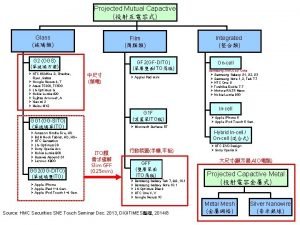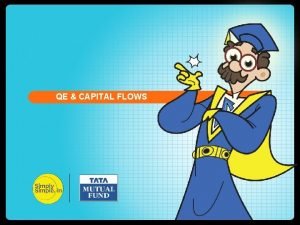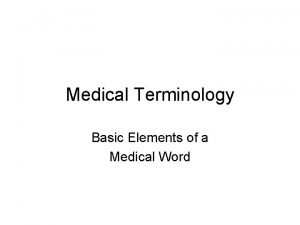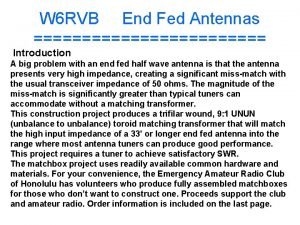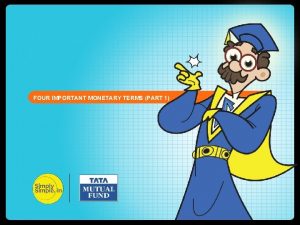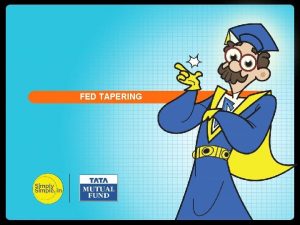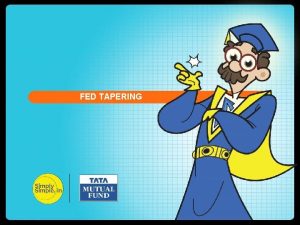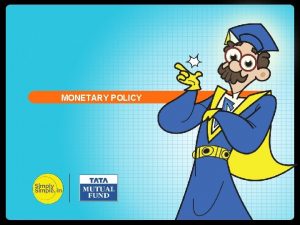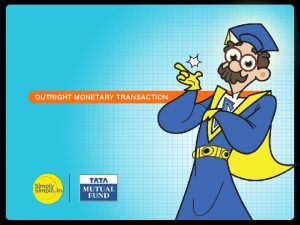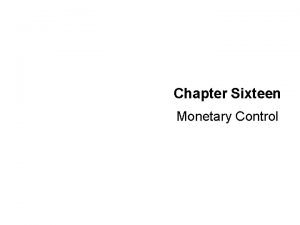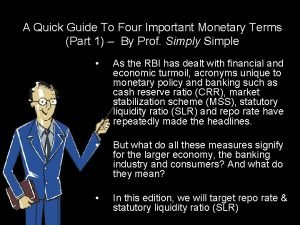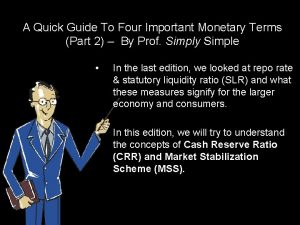FED TAPERING FOUR IMPORTANT MONETARY TERMS PART 2
















- Slides: 16

FED TAPERING FOUR IMPORTANT MONETARY TERMS (PART 2)

A Quick Guide To Four Important Monetary Terms (Part 2) – By Prof. Simply Simple

FOUR IMPORTANT MONETARY TERMS (PART 2) q In the last edition, we looked at repo rate & statutory liquidity ratio (SLR) and what these measures signify for the larger economy and consumers. q In this edition, we will try to understand the concepts of Cash Reserve Ratio (CRR) and Market Stabilization Scheme (MSS).

FOUR IMPORTANT MONETARY TERMS (PART 2) The Cash Reserve Ratio q CRR is a bank regulation that sets the minimum reserves each bank must hold to customer deposits and notes. q These reserves are designed to satisfy withdrawal demands, and would normally be in the form of currency stored in a bank vault (vault cash), or with a central bank.

FOUR IMPORTANT MONETARY TERMS (PART 2) Recently… q The RBI has been selling US dollars to stem the fall of the Indian Rupee, which has fallen 27% against the US Dollar since January. q For every dollar the RBI sells an equivalent amount of rupees is sucked out from the system. q In other words, liquidity will remain in the system if RBI stops selling dollars and allows the rupee to depreciate.

FOUR IMPORTANT MONETARY TERMS (PART 2) An Update! q The CRR has been cut by 100 basis points in two stages. With this, the RBI has brought down the CRR from 9% to its January 2007 level of 5. 5%. q Now, the outstanding deposit portfolio of the Indian banking industry is around Rs 34. 69 trillion. q This means a 100 basis points cut in CRR releases around Rs. 34, 690 crore into the system. q This includes certain other liabilities, besides deposits.

FOUR IMPORTANT MONETARY TERMS (PART 2) Now… q Banks can use this money to lend. A cut in CRR also increases banks’ income. RBI does not pay any interest on the cash balance kept with it. q Banks can earn 13. 5 -14% from the freed-up money if they lend to corporate customers with good ratings or around 7. 5% if they invest in government securities. q Theoretically, the level of CRR can be brought down to zero. This means, RBI can at best release Rs. 2. 2 trillion into the financial system to ease the liquidity constraint.

FOUR IMPORTANT MONETARY TERMS (PART 2) However… q This situation can also be achieved if the supply of dollars increases with foreign institutional investors (FIIs) buying Indian equities and local firms borrowing overseas. q The combination of adequate liquidity and low policy rate can bring the borrowing cost down for firms and individuals.

FOUR IMPORTANT MONETARY TERMS (PART 2) Market Stabilization Scheme q Till the time the rupee was rising against the dollar, the RBI was aggressively buying dollars from the market to stem the rise of the local currency. q This is because a strong local currency hurts exporters’ interest as their income, in rupee terms, comes down. q For every dollar RBI bought, an equivalent amount of rupees flowed into the system and that, in turn, was sucked out by bonds, floated under the market stabilization scheme.

FOUR IMPORTANT MONETARY TERMS (PART 2) Now… q Thus there was a liquidity overhang that was caused by the inflow of dollars. This forced the Government to mop up the rupees by creating the MSS bonds. q MSS was introduced by way of an agreement between the Government and the Reserve Bank of India (RBI) in early 2004. q Under the scheme, RBI issues bonds on behalf of the Government and the money raised under bonds is impounded in a separate account with RBI. q The money does not go into the Government account.

FOUR IMPORTANT MONETARY TERMS (PART 2) Recent Update! q The outstanding MSS bonds in RBI book are worth Rs. 1. 74 trillion and out of this, dated securities account for Rs. 1. 35 trillion with the rest being short-term treasury bills. q The RBI plans to buy back part of the MSS bonds to generate cash for banks which can reinvest them in government bonds that will be floated between now and March 2009. q In other words, banks will not be required to dip into their deposit pool to buy Government bonds.

FOUR IMPORTANT MONETARY TERMS (PART 2) Therefore… q The buy back will help the banks generate liquidity and the Government see its borrowing programme through. q However, the response of banks to the buy back programme will depend on the price of MSS bonds. q Since interest rates can only go down in coming days, banks may find staying invested in MSS bonds makes business sense.

FOUR IMPORTANT MONETARY TERMS (PART 2) To Sum Up q The Cash Reserve Ratio determines the proportion of bank deposits that is to be kept with the RBI. q The Market Stabilization Scheme was introduced by way of an agreement between the government and the RBI in early 2004. q Under the scheme, RBI issues bonds on behalf of the government and the money raised under bonds is impounded in a separate account with RBI. The money does not go into the government account.

FOUR IMPORTANT MONETARY TERMS (PART 2) Hope you have now understood the concept of Cash Reserve Ratio (CRR) and Market Stabilization Scheme (MSS).

In case of any query, please e-mail professor@tataamc. com

DISCLAIMER The views expressed in this lesson are for information purposes only and do not construe to be any investment, legal or taxation advice. The lesson is a conceptual representation and may not include several nuances that are associated and vital. The purpose of this lesson is to clarify the basics of the concept so that readers at large can relate and thereby take more interest in the product / concept. In a nutshell, Professor Simply Simple lessons should be seen from the perspective of it being a primer on financial concepts. The contents are topical in nature and held true at the time of creation of the lesson. This is not indicative of future market trends, nor is Tata Asset Management Ltd. attempting to predict the same. Reprinting any part of this material will be at your own risk. Tata Asset Management Ltd. will not be liable for the consequences of such action. Mutual Fund investments are subject to market risks, read all scheme related documents carefully.
 Forward contract hedging
Forward contract hedging Tapering fed
Tapering fed Taper angle
Taper angle Continuous parenteral nutrition
Continuous parenteral nutrition Tapering qe
Tapering qe Polynomial degrees and terms
Polynomial degrees and terms Like terms
Like terms Anatomical position definition
Anatomical position definition The word elements used in medical terminology are
The word elements used in medical terminology are Example of a news story
Example of a news story From most important to least important in writing
From most important to least important in writing Least important to most important
Least important to most important What are the four essential parts of a stock
What are the four essential parts of a stock Different parts of body
Different parts of body The mass media play an important
The mass media play an important End fed antenna length chart
End fed antenna length chart Federalist 78 definition
Federalist 78 definition

